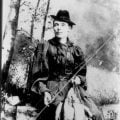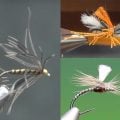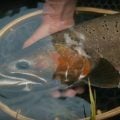How to Tie a Cased Caddis Larva
Producer: tightlinevideo
Cased caddis larva are abundant in many rivers and streams, and an excellent food source for trout of all persuasions. For an insect in its larval state that lives underwater, attached to rocks on the stream bottom, they’re remarkable engineers. They’re able to create protective houses using nothing more than fine, adhesive filaments spit from their mouths, and leaves, sticks and sediment collected from the stream bed. And, yes, trout do eat them, case and all.
The fly you see here, as simple as it is, does a incredible job of imitating cased caddis larva. The color of the exposed thread head can be changed to match the naturals, and the size of the fly can be altered a bit as well. This particular version does a good job of imitating Grannom caddis larva.
The fly starts with a size 16 Fulling Mill 5105 barbless hook. After getting the hook firmly secured in the jaws of your tying vise, load a bobbin with a spool of UTC 140 Denier, again, in a color to match the naturals, here, fluorescent chartreuse.
Get the thread started on the hook shank, behind the eye, and take thread wraps rearward to the midpoint of the shank, then snip off the excess tag.
Pheasant tail fibers are used to form the case of the fly. Pull 6-8 long fibers down, perpendicular to the stem, and grip them tight. Puling the stem away from the fibers will help to keep the butts, and thus the tips, well aligned. It’s a good idea to snip the curly butt ends off, as they tend to catch on your tying thread as you wrap. Also, snipping the very tips off is helpful as they’re quite brittle.
While holding on to the fibers by the tip end with your left hand, give your bobbin an ample counterclockwise spin, as if you’re looking down on it. This will reverse cord your thread, so when you lay the pheasant tail fibers on top of the hook shank, the first thread wrap will want to jump slightly rearward and catch them. Once they’re trapped, continue taking rearward wraps of tying thread to anchor the fibers to the top of the hook shank, all the way back to the start of the hook bend. Then, leave your tying thread right there.
Get hold of the pheasant tail fibers and, without twisting them, begin taking touching wraps behind your tying thread and up the hook shank. Watch out for that sharp hook point as it can easily break the fibers. Keep taking touching wraps with the pheasant tail, up the shank until you reach the back edge of the hook eye. There, secure the fibers with a few thread wraps over top of them, one beneath them behind the eye, then a few more over top. This will allow you to confidently break the excess fibers off. Breaking them off, as opposed to snipping them, generally results in a much smaller, neater head on the fly.
After all the fibers have been broken off close, take just a few more wraps of tying thread to cover up anything unsightly then stop wrapping at the start of the pheasant tail body.
Get hold of your whip finish tool and use it to do a back to front, 4 or 5 turn whip finish, be sure to seat the knot really well then snip or cut your tying thread free.
Pick up your head cement, here, Sally Hansen Hard as Nails, and apply an ample amount to the entire back of the fly. You can use wire to reinforce the pheasant tail fibers if you like, but I’ve found the adhesive basically makes this unnecessary. Once the adhesive sinks in and dries, the fly will be plenty durable and ready to fish.
It’s amazing to me how a pattern this simple can be so effective.
How to Tie a Caribou Caddis
How to Tie a Catskill-Style Hendrickson











